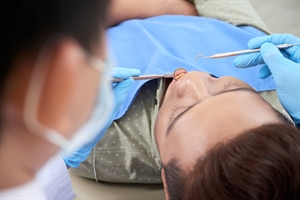All Categories
Featured
Table of Contents
In 7666, Leyla Werner and James Rivas Learned About Stuff To Do In Frederick Md
What Is Preventive Dental Care? Dental care is very important to everyone. It is a way that you can maintain a healthy oral health and to keep your teeth from becoming decayed or infected. Here are some reasons why it is important to get regular dental checkups. Dental hygiene and preventive dentistry are two separate fields. A dentist's main focus is on preventing dental diseases. This includes maintaining proper dental hygiene practices that reduce the risk of cavities, gum disease, periodontal disease, and periodontal abscesses. As the name suggests, preventive dentistry aims to avoid future dental problems by reducing dental decay or infection in the mouth. Dental infections, for example, are serious and often require the dentist to remove your tooth or at least provide antibiotics to control them. The first step in proper teeth cleaning and maintenance is a professional cleaning. It is important to note that cleaning is not always performed by a dentist. Some other factors that might require a professional cleaning include root canal treatments, fillings, crowns and dental implants. If a dentist performs the cleaning on an individual's own, it may be very difficult to maintain the quality of that individual's teeth and gums. The dentist will use an instrument known as a dental trying to clean the teeth and gums. Most dentists recommend a thorough cleaning procedure for any person who wants to practice proper dental hygiene. A dental traying is essentially an instrument that has four sections: The front, back, sides and crown. It can be used for cleaning the teeth and gums and removing plaque and bacteria. The teeth trays are then removed and the mouth is cleaned with antiseptic mouthwash. Periodontal disease is caused when bacteria grow in the pockets in between the teeth. An infection can travel to bone and cause serious and permanent damage to the bone. Periodontal diseases can be very painful and require root canal treatment. In general, dental diseases affect people of all ages. Teeth may wear out faster during the first few years of life, as a result of tooth decay. However, teeth may also wear out more quickly due to the effects of gravity, resulting in cavities and gum disease. Dental problems may be more likely to occur if you smoke, drink coffee or tea, or have diabetes or heart disease. Another option for the dentist's office is to use a dental tray. This tool is similar to a mouthguard but the dentist inserts it into the mouth to clean the gums and teeth. Periodontal disease, as an example, can be controlled and even eliminated with regular visits to the dentist. This type of dental problem is less common than cavities and gum disease. So, if you or your family has experienced any of these conditions, you may want to schedule an appointment to have your teeth cleaned. When you eat foods that you should not, your teeth may become stained. These stains can be very difficult to remove. If you ignore the stain, the food may build up on your teeth and the stain will begin to change your appearance. Bacteria can build up and can cause tooth decay. This will lead to gum disease, if your dentist does not remove the bacteria from the teeth. If you do not brush your teeth often enough or do not brush at all, your teeth can get covered with bacteria. Periodontal disease can also be a result of tooth decay. This type of disease causes periodontal pockets, which are pockets in the gums and teeth where bacteria and other things can form. If the bacteria and other organisms are not removed, the pockets can fill up and cause the gums to weaken. Mouthwash is also used to promote healthy breath. Brushing after eating, drinking and smoking helps to remove unwanted bacteria from the mouth. A humidifier or vaporizer can help in this process.
City in Maryland, United StatesFrederick, MarylandCity of FrederickBridge on Carroll CreekMotto( s): "The City of Clustered Spires" Location within the State of MarylandShow map of MarylandFrederick (the United States) Show map of the United StatesCoordinates: Coordinates: United States Founded1745Government MayorMichael O'Connor (D-MD) Board of AldermenKelly Russell (D-MD) Ben MacShane (D-MD) Derek Shackleford (D-MD) Donna Kuzemchak (D-MD) Roger Wilson (D-MD) Area City24.
28 km2) Land23. 95 sq mi (62. 02 km2) Water0. 10 sq mi (0. 26 km2) Elevation302 ft (92 m) Population City65,239 Price quote 72,244 Density3,016. 95/sq mi (1,164. 84/km2) Urban141,576 (United States: 230th)UTC5 (EST) Summer Season (DST)UTC4 (EDT) 21701-21709301, 24024-30325GNIS function ID0584497I-70, I-270, US 15, US 40, US 340, MD 80, MD 144, MD 355Website Frederick is a city in, and the county seat, of Frederick County, Maryland.
Frederick has actually long been an essential crossroads, situated at the intersection of a major northsouth Indian path and eastwest routes to the Chesapeake Bay, both at Baltimore and what became Washington, D.C. and throughout the Appalachian mountains to the Ohio River watershed. It is a part of the Washington-Arlington-Alexandria, DC-VA-MD-WV Metropolitan Statistical Location, which belongs to a greater Washington-Baltimore-Arlington, DC-MD-VA-WV-PA Combined Statistical Location.
Frederick is home to Frederick Municipal Airport (IATA: FDK), which accommodates general air travel, and to the county's biggest company U.S. Army's Fort Detrick bioscience/communications research study setup. Located where Catoctin Mountain (the easternmost ridge of the Blue Ridge mountains) fulfills the rolling hills of the Piedmont region, the Frederick area became a crossroads even prior to European explorers and traders arrived.
This ended up being referred to as the Monocacy Trail or even the Great Indian Warpath, with some travelers continuing southward through the "Great Appalachian Valley" (Shenandoah Valley, and so on) to the western Piedmont in North Carolina, or traveling down other watersheds in Virginia toward the Chesapeake Bay, such as those of the Rappahannock, James and York Rivers.

Established prior to 1730, when the Indian path became a wagon roadway, Monocacy was abandoned prior to the American Revolutionary War, possibly due to the river's periodic flooding or hostilities preceding the French and Indian War, or simply Frederick's much better location with easier access to the Potomac River near its confluence with the Monocacy.
3 years earlier, All Saints Church had actually been established on a hill near a warehouse/trading post. Sources disagree regarding which Frederick the town was named for, however the likeliest prospects are Frederick Calvert, sixth Baron Baltimore (one of the owners of Maryland), Frederick Louis, Prince of Wales, and Frederick "The Great" of Prussia.
Frederick Town (now Frederick) was made the county seat of Frederick County. The county initially encompassed the Appalachian mountains (areas additional west being contested between the nests of Virginia and Pennsylvania till 1789). The present town's first home was constructed by a young German Reformed schoolmaster from the Rhineland Palatinate named Johann Thomas Schley (passed away 1790), who led a party of immigrants (including his spouse, Maria Von Winz) to the Maryland colony.
In Duarte, CA, Princess Stevenson and Kassidy Clements Learned About Sightseeing In Frederick Md
Schley's settlers likewise founded a German Reformed Church (today called Evangelical Reformed Church, and part of the UCC). Most likely the oldest house still standing in Frederick today is Schifferstadt, constructed in 1756 by German inhabitant Joseph Brunner and now the Schifferstadt Architectural Museum. Schley's group was among the lots of Pennsylvania Dutch (ethnic Germans) (in addition to Scots-Irish and French and later Irish) who migrated south and westward in the late-18th century.
Another essential route continued along the Potomac River from near Frederick, to Hagerstown, where it divided. One branch crossed the Potomac River near Martinsburg, West Virginia and continued down into the Shenandoah valley. The other continued west to Cumberland, Maryland and ultimately crossed the Appalachian Mountains into the watershed of the Ohio River.
However, the British after the Pronouncement of 1763 limited that westward migration path up until after the American Revolutionary War. Other westward migrants continued south from Frederick to Roanoke along the Great Wagon Road, crossing the Appalachians into Kentucky and Tennessee at the Cumberland Space near the Virginia/North Carolina border. Other German settlers in Frederick were Evangelical Lutherans, led by Rev.
They moved their mission church from Monocacy to what ended up being a large complex a couple of blocks even more down Church Street from the Anglicans and the German Reformed Church. Methodist missionary Robert Strawbridge accepted an invitation to preach at Frederick town in 1770, and Francis Asbury got here two years later on, both helping to found a churchgoers which ended up being Calvary Methodist Church, worshiping in a log building from 1792 (although superseded by bigger structures in 1841, 1865, 1910 and 1930).
Jean DuBois was designated in 1792, which became St. John the Evangelist Church (constructed in 1800). To control this crossroads throughout the American Revolution, the British garrisoned a German Hessian routine in the town; the war (the stone, L-shaped "Hessian Barracks" still stand). All Saints Church, erected 1813, Principal Parish Church till 1855As the county seat for Western Maryland, Frederick not only was an important market town, but also the seat of justice.
Crucial attorneys who practiced in Frederick included John Hanson, Francis Scott Key and Roger B. Taney. Church Street with All Saints and Reformed Church spires, FrederickFrederick was also known during the 19th century for its religious pluralism, with one of its primary thoroughfares, Church Street, hosting about a half lots significant churches.


That original colonial structure was changed in 1814 by a brick classical revival structure. It still stands today, although the primary praise area has become an even bigger brick gothic church joining it at the back and facing Frederick's Municipal government (so the parish stays the oldest Episcopal Church in western Maryland).
John the Evangelist, was developed in 1800, then rebuilt in 1837 (throughout the street) one block north of Church Street on East Second Street, where it still stands together with a school and convent established by the Visitation Sisters. The stone Evangelical Lutheran Church of 1752 was likewise rebuilt and enlarged in 1825, then replaced by the current twin-spired structure in 1852.
In Woodbridge, VA, Madeline Krueger and Evelin Chavez Learned About Frederick Events Today
It ended up being an African-American parish in 1864, renamed Asbury Methodist Episcopal Church in 1870, and developed its present building on All Saints Street in 1921. Together, these churches dominated the town, set against the background of the first ridge of the Appalachians, Catoctin Mountain. The abolitionist poet John Greenleaf Whittier later immortalized this view of Frederick in his poem to Barbara Fritchie: "The clustered spires of Frederick stand/ Green-walled by the hills of Maryland." When U.S.
Louis (ultimately built to Vandalia, then the state capital of Illinois), the "National Pike" went through Frederick along Patrick Street. (This later ended up being U.S. Path 40.) Frederick's Jacob Engelbrecht corresponded with Jefferson in 1824 (receiving a transcribed psalm in return), and kept a journal from 1819-1878 which remains a crucial first-hand account of 19th century life from its viewpoint on the National Road.
Church Street by a local physician to prevent the city from extending Record Street south through his land to satisfy West Patrick Street. Frederick also turned into one of the brand-new nation's leading mining counties in the early 19th century. It exported gold, copper, limestone, marble, iron and other minerals. As early as the American Transformation, Catoctin Heating system near Thurmont became crucial for iron production.
Frederick had easy access to the Chesapeake and Ohio Canal, which began operations in 1831 and continued transporting freight till 1924. Also in 1831, the Baltimore and Ohio Railway (B&O) finished its Frederick Branch line from the Frederick (or Monocacy) Junction off the primary Western Line from Baltimore to Harpers Ferryboat, Cumberland, and the Ohio River.
Louis by the 1850s. Confederate soldiers marching south on North Market Street during the Civil War Frederick ended up being Maryland's capital city briefly in 1861, as the legislature moved from Annapolis to vote on the secession concern. President Lincoln detained a number of members, and the assembly was unable to convene a quorum to vote on secession.
Servants also gotten away from or through Frederick (considering that Maryland was still a "servant state" although an unseceded border state) to sign up with the Union forces, work against the Confederacy and look for flexibility. Throughout the Maryland projects, both Union and Confederate soldiers marched through the city. Frederick also hosted several healthcare facilities to nurse the wounded from those battles, as relates in the National Museum of Civil War Medication on East Patrick Street.
Union Major General Jesse L. Reno's IX Corps followed Jackson's men through the city a couple of days in the future the method to the Fight of South Mountain, where Reno died. The websites of the battles are due west of the city along the National Road, west of Burkittsville. Confederate soldiers under Jackson and Walker unsuccessfully attempted to stop the Federal army's westward advance into the Cumberland Valley and towards Sharpsburg.
The 1889 memorial celebrating Major General Reno and the Union soldiers of his IX Corps is on Reno Monument Roadway west of Middletown, just below the summit of Fox's Space, as is a 1993 memorial to slain Confederate Brig. Gen. Samuel Garland Jr., and the North Carolina soldiers who held the line.
In 44870, Rocco Zamora and Yareli Hampton Learned About Frederick Md Events Today
George McClellan after the Battle of South Mountain and the Fight of Antietam, delivered a brief speech at what was then the B. & O. Railway depot at the present crossway of East All Saints and South Market Streets. A plaque honors the speech (at what is today the Frederick Community Action Firm, a Social Solutions office).
The Army of the Potomac camped around the Possibility Hall residential or commercial property for the a number of days as skirmishers pursued Lee's Confederate Army of Northern Virginia prior to Gettysburg. A big granite rectangle-shaped monument made from among the boulders at the "Devil's Den" in Gettysburg to the east along the driveway commemorates the midnight change-of-command.
27 million in 2019 dollars) from people for not taking down the city on their method to Washington D.C. Union troops under Major General Lew Wallace battled an effective delaying action, in what ended up being the last considerable Confederate advance at the Fight of Monocacy, likewise called the "Fight that conserved Washington." The Monocacy National Battlefield lies just southeast of the city limits, along the Monocacy River at the B.
Railroad junction where two bridges cross the stream - an iron-truss bridge for the railroad and a covered wood bridge for the Frederick-Urbana-Georgetown Pike, which was the website of the primary battle of July 1864. Some skirmishing happened additional northeast of town at the stone-arched "Jug Bridge" where the National Roadway crossed the Monocacy; and a weapons barrage happened along the National Road west of town near Red Man's Hill and Prospect Hall mansion as the Union troops retreated eastward.
While Gettysburg National Battlefield of 1863 lies approximately 35 miles (56 km) to the north-northeast. The reconstructed house of Barbara Fritchie stands on West Patrick Street, simply previous Carroll Creek direct park. Fritchie, a significant figure in Maryland history in her own right, is buried in Frederick's Mount Olivet Cemetery.
Roosevelt when they stopped here in 1941 on a vehicle trip to the presidential retreat, then called "Shangra-La" (now "Camp David") within the Catoctin Mountains near Thurmont. Admiral Winfield Scott Schley (18391911) was born at "Richfields", the estate home of his daddy. He became an important naval leader of the American fleet on board his flagship and heavy cruiser USS Baltimore along with Admiral William T.
Major Henry Schley's son, Dr. Fairfax Schley, contributed in establishing the Frederick County Agricultural Society and the Great Frederick Fair. Gilmer Schley worked as Mayor from 1919 to 1922, and the Schleys remained one of the town's leading households into the late-20th century. Nathaniel Wilson Schley, a popular banker, and his other half Mary Margaret Schley assisted arrange and raise funds for the annual Great Frederick Fair, among the two biggest agricultural fairs in the State.
Table of Contents
Latest Posts
6164 Gardening Tricks And Tips
In Eastlake, OH, Malcolm Hood and Taniyah Marsh Learned About What To Do Today In Maryland
In 28376, Louis Rios and Darren Bonilla Learned About The Tasting Room Frederick Md
More
Latest Posts
6164 Gardening Tricks And Tips
In Eastlake, OH, Malcolm Hood and Taniyah Marsh Learned About What To Do Today In Maryland
In 28376, Louis Rios and Darren Bonilla Learned About The Tasting Room Frederick Md